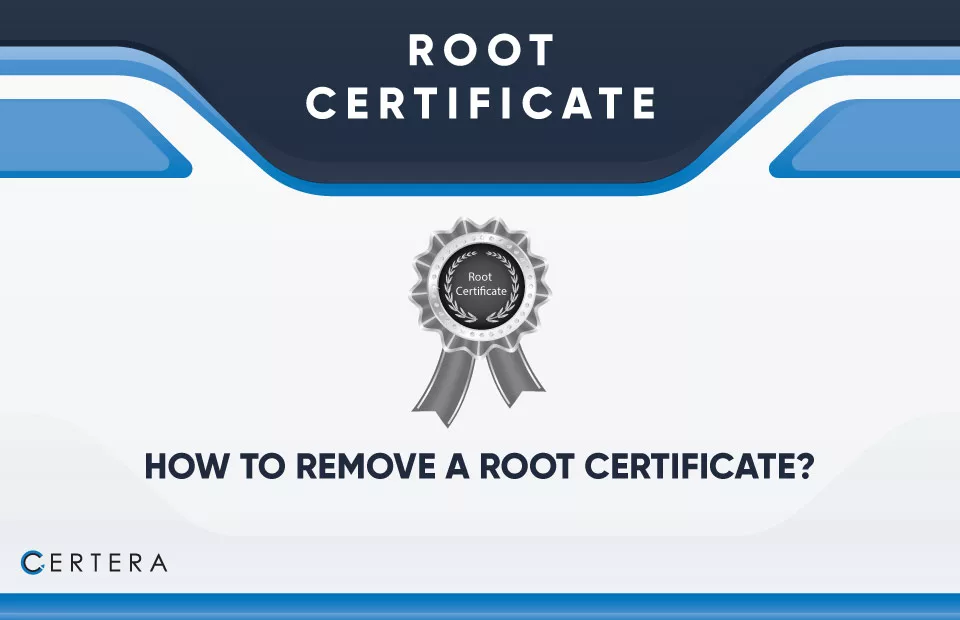How to Remove a Root Certificate?

Our guide will cover steps for removing roots for Apple, Microsoft, and Mozilla digital certificates. Since the SSL Certificates are crucial, they must all be connected to a trusted root certificate.
This process, known as certificate chaining, is the foundation of establishing trust in online interactions.
Your browser is cautious as you use the internet, not readily granting trust to every website it encounters. When you visit a website with a digital certificate, your browser ensures that the certificate is chained back to a trusted root.
Sometimes, you might be prompted to install intermediate certificates along with your SSL, which aids in completing the certificate chain.
With this post, you can confidently navigate the intricacies of certificate management. Explore the essential steps to ensure a secure and trustworthy online experience.
How Does Removing a Root Certificate work?
Facilitating the process of certificate chaining on the browser’s end, significant browsers maintain a trusted root store comprising pre-downloaded X.509 certificates, commonly known as Digital Certificates.
These root certificates are securely guarded and belong to Certificate Authorities that store their private keys offline on specialized hardware tokens in highly-secured data centers.
Among the four major root stores, both Apple and Microsoft have their own for their respective operating systems. At the same time, Mozilla maintains a dedicated root store, and Android also has its own. Notably, Google Chrome, one of the most popular browsers in America, utilizes the root store provided by the underlying operating system.
While browsers exercise caution in trusting random digital certificates, they wholeheartedly trust the roots in their trust store. As long as your certificate can be traced back to one of these trusted roots, the browsers will also extend their trust to your certificate.
Though browsers usually remove problematic roots from their lists in the subsequent updates, there might be instances when immediate removal is required. How do you go about removing a root certificate promptly and efficiently? Let’s explore the steps to accomplish this.
!!CAUTION!! It is crucial to proceed with caution, as tampering with root certificates can lead to severe issues. We strongly advise backing up your computer before proceeding. We will not be held responsible for any problems.
Remove Root Certificates from Apple Devices:
Unraveling the process of removing a root certificate on Apple devices requires administrator access, much akin to the procedure on Windows systems. It is essential to exercise caution during this process to avoid any unintended consequences.
To begin, ensure you have administrator access, and then follow these steps:
Step 1: Select the Finder, and click on “Go.” From the dropdown menu, choose “Utilities” (Alternatively, you can press Shift + Command + U).
Step 2: Double-click on “KeyChain Access” to open the application.
Step 3: In the KeyChain Access window, select “System Roots.”
Step 4: Locate the root certificate you wish to delete and double-click on it to open its details.
Step 5: In the window that appears, find the section labeled “Trust.”
Step 6: Under the “Trust” section, locate the option “When using this certificate” and select “Never trust.”
Following these steps carefully can remove the root certificate from your Apple machine. Always exercise caution during this process to avoid any potential issues or disruptions to your system.
Steps for iPhone and iPad:
If you need to remove a Root Certificate from your iPhone or iPad, it’s a straightforward process. As mobile devices have become the primary means for internet browsing, they handle certificate chaining and trust verification.
Managing Root Certificates on your iPhone or iPad might become necessary. Here’s How to do it:
Step 1: Open your iPhone or iPad’s Settings from the Home screen.
Step 2: In the Settings menu, select “General.”
Step 3: Look for and select “Profile.” There’s nothing to delete if you don’t see any profiles listed.
Step 4: Choose the specific Profile corresponding to the Root Certificate you want to remove.
Step 5: Once you’ve selected the Profile, click on “Delete Profile.”
Step 6: If prompted, enter your passcode to proceed.
Step 7: Finally, confirm the deletion by selecting “Delete” one more time.
This is how you can successfully remove the unwanted Root Certificate from your iPhone or iPad. Always be cautious and delete the correct profile to avoid unintended consequences.
This approach will help you maintain a secure and trustworthy browsing experience on your mobile device.
How to Remove Root Certificates on Windows?
If you need to remove a root certificate from a Windows system, we’ve covered you with clear instructions tailored to Windows 7. Rest assured.
We’ve updated this article to include the necessary steps for removing roots on the Windows 7 operating system.
Follow these straightforward steps:
Step 1: Begin by pressing the Windows or Start button on your keyboard.
Step 2: Type “MMC” into the run box and hit Enter. This action will launch the Microsoft Management Console.
Step 3: Click “File” from the top menu in the Microsoft Management Console window.
Step 4: Select “Add/Remove Snap-In” from the options presented.
Step 5: Locate and click on “Certificates” in the console tree. This section contains the root certificate that you wish to delete.
Step 6: Select the certificate you want to remove once you’ve identified it.
Step 7: Next, click the “Delete” option in the Action menu.
Step 8: A confirmation prompt will appear. Click “Yes” to proceed with the removal.
You can successfully remove the unwanted root certificate from your Windows 7 OS by following these steps diligently. Always exercise caution when making changes to your system to ensure a smooth and hassle-free experience.
Remove a Root Certificate from Windows 10/8
The process is straightforward if you need to remove a Root Certificate from the Windows 10/8 trust store.
With that important disclaimer out of the way, let’s proceed with the steps:
Step 1: Begin by pressing the Windows or Start button on your keyboard.
Step 2: Type “MMC” into the run box and hit Enter. This will launch the Microsoft Management Console.
Step 3: Click “File” from the top menu in the Microsoft Management Console window.
Step 4: Select “Add/Remove Snap-In” from the options provided.
Step 5: Choose “Certificates” from the left pane and click “Add.”
Step 6: In the next window, select “Computer Account,” then click “Next.” Choose “Local Computer” and click “Finish.”
Step 7: Expand the “Certificates (Local Computer)” section in MMC. This will reveal the certificate stores.
Step 8: Continue expanding the options until you find the desired Root Certificate that you wish to remove or disable. Click on the “Certificates” folder.
Step 9: In the list of certificates, locate the specific one you want to delete. Right-click on it and choose “Properties.”
Step 10: Within the certificate properties window, select “Disable all purposes for this certificate,” then click “Apply.”
Step 11: Finally, to apply the changes, restart your machine.
These steps diligently help to successfully remove or disable the chosen Root Certificate from your Windows 10/8 system. Always exercise caution and ensure a backup before changing your computer’s certificate store.
This approach will help you maintain a secure and reliable computing environment.
Root Certificate Removal Process for Android devices
If you need to remove a Root Certificate from your Android device, the process is simple and essential for maintaining a secure trust store. Android phones have their dedicated trust store that requires proper management. Here’s how you can go about it:
Step 1: Begin by opening your Android device’s Settings.
Step 2: In the Settings menu, find and select “Security.”
Step 3: Look for the option labeled “Trusted Credentials.”
Step 4: Once you’ve located the “Trusted Credentials” section, you will find a list of certificates. Select the specific certificate that you wish to remove.
Step 5: After selecting the certificate, press the “Disable” button to initiate removal.
These steps can successfully remove the unwanted Root Certificate from your Android device. Always exercise caution when managing certificates to ensure a safe and secure browsing experience.
This approach will help you maintain the integrity of your device’s trust store and enhance your overall digital security.
Instructions for Removing a Root Certificate on Mozilla’s Firefox Browser
When removing a Root Certificate on Mozilla’s Firefox browser, the process is slightly different from Google Chrome, as Firefox utilizes its unique and proprietary trust store managed by the Mozilla organization.
To remove a root certificate on Firefox, you must access the trust store directly through your browser settings. Here’s how you can do it:
Step 1: Begin by opening Mozilla Firefox and clicking on the Firefox menu at the browser window’s top right corner.
Step 2: From the dropdown menu, select “Options.”
Step 3: In the Options window, click “Advanced” from the left-hand side menu, and then click on the “Certificates” tab.
Step 4: Under the “Certificates” tab, click on the “View Certificates” button.
Step 5: A new window will pop up, showing various tabs. Select the “Authorities” tab to view the list of trusted root certificates.
Step 6: In the list of authorities, locate the specific Root Certificate you wish to delete.
Step 7: Once you’ve found the desired certificate, click the “Delete or Distrust” button to initiate removal.
Step 8: A confirmation dialog box will appear. Verify that you have selected the correct Root Certificate, and then click “OK” to confirm the deletion.
You can remove the unwanted Root Certificate from Mozilla Firefox by following these steps diligently.
Always exercise caution when making changes to your trust store, and ensure you are deleting the correct certificate to avoid any potential disruptions to your browsing experience.
This approach will help you maintain a secure and reliable environment using Mozilla Firefox.
